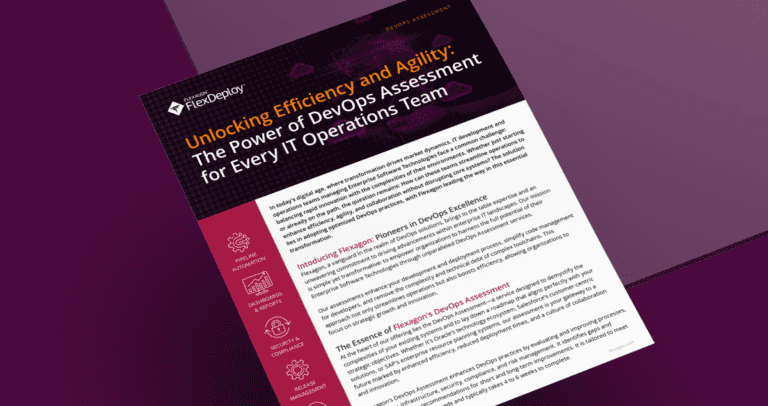Enhancing your DevOps pipeline is a crucial part of optimizing the IT lifecycle. For instance, you’ll streamline workflows, cut production time, and improve inter-team communications—all effective ways to deliver better software.
At the latest Oracle CloudWorld, Flexagon shared its FlexDeploy platform for DevOps, which supports Oracle EBS and Salesforce. This innovative technology also allows developers to automate the build, test, and deploy stages of software production.
Every year, more companies are adopting DevOps practices, largely due to the ability of continuous integration and delivery to accelerate software releases. Cloud migration is another hugely popular theme.
At first, it can feel intimidating to upgrade the procedures used by your development and operations teams to make software. As such, when implementing a more efficient DevOps pipeline, the more knowledge you have, the more prepared you’ll be to take on the challenge. Once you master these essential processes, you’ll be ready to incorporate DevOps and DevSecOps principles more widely.
Here, we’ll look at the phases of a DevOps pipeline and how to make your pipeline continuous—putting you on the path to reliable, fast, and repeatable deployments.
Phases of a DevOps Pipeline
A DevOps pipeline consists of several stages, and dividing the process into steps will help to facilitate its execution. Although each phase may use its own tools and techniques, they all work together to push code through from start to finish.
The stages include plan, develop, test, deploy, release, operate, and retire. These can be varied to suit your organizational needs.
Plan
A manager leads the team in devising a project strategy. Your goal is to meet the relevant business needs by figuring out how to make them workable in practice. Employ an agile system to devise a roadmap, establishing specific tasks and dates.
Develop
In this stage, you write the code itself. Developers commit their contributions to a source control repository, while frameworks and programming tools assist the team in working together and building solid products. In DevOps, you want to integrate new code frequently.
Test
Once the code has been developed, it’s time to test it. Use separate test environments to make it safe to run the code through a demanding range of tests. In a DevOps pipeline you should automate as much of the testing as possible.
Deploy
When code passes the testing phase, it’s ready for deployment. Given the multiple code reviews and tests, you can have confidence that the software will function well. As with testing, it’s wise to automate deployment—something that FlexDeploy can help you achieve.
Release
In this phase, code moves to the production environment. Sometimes code doesn’t make it this far and gets sent back to previous stages for rework. Your DevOps pipeline may feature regular releases, which you should also automate if feasible.
Operate
After the code has been released, there’s still work to be done. Because DevOps includes operations, you also have to monitor the functioning software. Here, it’s important to listen to users and observe performance data. These results will then inform the next iteration of your DevOps pipeline.
Retire
Once the productive life of the software is at an end, it makes sense to remove the code from service; one reason being that the project may draw resources away from newer releases. In addition to removing the software itself, you can also remove any associated data that is no longer necessary for business or regulatory purposes.
Making Your Pipeline Continuous
A central feature of DevOps is to make processes continuous. That is, you build and release software in an ongoing and responsive manner, not in the infrequent manner of conventional development. A continuous pipeline contributes to clean and secure code.
There are many aspects of the pipeline that can be made continuous:
- Planning: Instead of scheduled releases each month or year, planning unfolds naturally as part of the entire development lifecycle.
- Development: Code for new features and bug fixes works its way into multiple versions, cycling through iterations. For instance, you can freely add new code to older versions or add external libraries to new versions.
- Integration: Frequent code updates go through testing before being merged into branches. Continuous integration allows many developers to collaborate at high speed while retaining the stability of the software.
- Testing: As with development, continuous testing occurs at any time, on any branch. When new code is written, it must undergo testing to prevent it from breaking a working version.
- Monitoring: Here, you can utilize automation tools to track processes and receive notifications when a system needs attention. This alleviates the burden of having to constantly watch systems, as happens with traditional monitoring.
- Deployment: By automating the movement of code into production, you’ll save time and reduce errors. An orchestration platform like FlexDeploy continuously adds improvements—usually in small increments.
- Operations: Managed resources, such as cloud infrastructure, regularly adjust to your needs. The information from continuous monitoring drives operations and minimizes downtime.
- Feedback: User and system feedback are available throughout the entire DevOps pipeline. This enables frequent adjustments to ensure functionality and attain the business value you initially planned for.
In an environment of complex modern demands, applying continuous processes cuts spending and downtime, reduces waste, and speeds delivery and deployment.
As a leader in DevOps solutions, we offer a DevOps Assessment tailored to revolutionize your IT operations, ensuring you’re always a step ahead.

Maximize Your DevOps Pipeline with Flexagon
When you’re ready to bring your software development to the next level, implement DevOps with Flexagon. The FlexDeploy platform is built specifically for streamlining DevOps pipelines, providing speed, consistency, and visibility for effective management of software development and delivery. It features easy-to-use automation tools and has over a hundred plugins and integrations.
Furthermore, FlexDeploy supports the adoption and enablement of DevOps as your needs mature. Not only does it increase developer productivity and operational efficiencies, which lowers costs, FlexDeploy also reduces the risk of security and compliance issues to optimize both user experience and software delivery performance. From coding to testing and deployment, this is the best way to deliver quality software.
As DevOps is a new approach to creating software, it calls for an innovative tool. FlexDeploy unites development and operations to work toward common objectives. It allows the whole team to collaborate on consistent processes—and hit business goals.
FlexDeploy simplifies even the most complex projects that have extensive dependencies. In addition, it natively understands common programming languages and works with your favorite tools throughout the DevOps pipeline.
Continuous integration and continuous delivery ensure a smooth series of measurable improvements, while dashboards and reports facilitate the tracking of results. With FlexDeploy, you’ll produce more value at lower cost and risk.
This is a platform for the cloud era. Let FlexDeploy help you manage the pipeline for maximum performance. Request a demo now!



